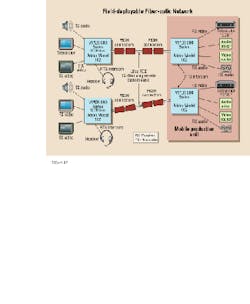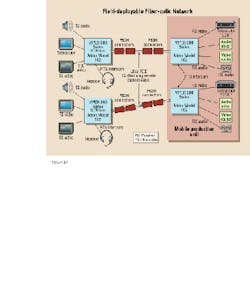Fiber drives the fairway
Fiber drives the fairway
CBS Sports has discovered the benefits of fiber for video broadcasts of golf and other sporting events.
MICHAEL C. CREAMER, FAV Marketing THOMAS G. HAZELTON, Fiber Systems International
The world saw new players emerge in the field of professional golf in 1997. Yet as names like Tiger Woods and Justin Leonard made national and world headlines, another "innovative player" quietly made its presence known in wide territorial coverage of this and other sports: fiber-optic technology. Just as new players have changed the world of golf, fiber has now changed the world of live event broadcasting.
At the Doral Open, held in Miami, FL, last March, cbs Sports committed to a deployable fiber-optic network, which would extend the reach of broadcast-quality video and audio to remote greens from broadcast towers on the 16th, 17th, and 18th holes, including the announcer`s tower. This would enable cbs to bring the tournament closer and make it clearer to the viewing audience. This initial application of ruggedized broadcast fiber systems for golf tournaments could prove to be a milestone for the broadcast sports industry. Not only does this enabling technology enhance golf coverage, but it should also improve coverage of other sporting events, such as football, basketball, the Olympics, and even auto racing.
Why fiber?
Until recently, sports broadcasters shied away from fiber-optic solutions for coverage of live outdoor events due to the perceived relative fragility of the associated electronics, connectors, and cable. However, the industry has seen the development in the past few years of a completely field-deployable fiber-optic backbone designed for outside broadcasting.
Such a backbone brings fiber`s several advantages fully into play. For example, deployable fiber-optic backbones are lighter, easier, and quicker to set up. Time is money, and mobile teams have little time for dress rehearsal. Reducing labor from four technicians for four days to, typically, two technicians for one day is a great advantage.
In addition, each of the four fiber-optic conductors in a cable can replace up to 64 audio copper-pair or 2 coaxial cables. Reduction in the number of cables deployed reduces the time and labor interval necessary to "wire" an entire golf course. Meanwhile, reducing the amount of coaxial and copper cabling reduces the weight of the transport systems by more than 90%. Broadcast mobile units will be smaller and travel lighter in the future.
Fiber transmission systems also reduce the amount of phase delay and distortion of baseband video and broadcast quality audio. In the system deployed at the Doral Open, the typical audio dynamic range increased to 105 dB (A-weighted) with a frequency response of 0.1 kHz to 25 kHz flat (۪.01 dB) using 20-bit analog-to-digital and digital-to-analog converters. Total harmonic distortion (20 Hz to 20 kHz) was ٞ.05%. The typical video performance was 100 over 40 ire (input relative equation) level, with a signal-to-noise ratio (weighted) of 70 dB, differential gain of ٠%, and a differential phase of ٞ.5%.
Cameras, effects/talent microphones, and intercom systems are multiplexed and routed to multiple remote towers on the golf course. Distances from the mobile production studio, typically limited to 5000 ft for traditional copper systems, are no longer a concern. Fiber systems can extend sports broadcasting over distances as great as 10 mi.
Since there are no copper signal conductors in a fiber-optic system, ground loops and 50/60-Hz hum are eliminated from the broadcast transmission system for both audio and video. In sum, with their virtually unlimited bandwidth capability, fiber-optic backbones are the enablers for future digital and high-definition technology over this same optical system.
The challenge of a great golf course
Most fiber-optic telecommunications systems have been designed to function within a static or "fixed" network. However, the broadcast industry creates one of the most demanding environments for optical electronics and communication interconnect systems. Furthermore, mobile units never know what their optical decibel link loss will be until shortly before each tournament. Both optical electronics and fiber interconnect systems have to function in all types of harsh outdoor conditions, week after week, with minimal maintenance. All systems have to be easily deployed and quickly repaired or redeployed.
To meet such a challenge, cbs Sports brought together a team of three manufacturers of deployable fiber-optic equipment: Telecast Fiber Systems Inc., Worcester, MA; Fiber Systems International, Richardson, TX; and Optical Cable Corp., Roanoke, VA.
With this team in place, cbs Sports pioneered the concept of a ruggedized deployable fiber-optic backbone for professional golf tournaments that require televised coverage over a broad territory. Although the discrete systems existed (electronics, connectors, and cable), the total system solution had never been field-proven for singlemode fiber, which promises the ultra-high bandwidths necessary for high-definition digital video.
The overall broadcast fiber backbone was designed around Telecast Fiber Systems` Viper 800 Series, which includes baseband video modules and demodulators, and the 32-channel Adder Model 162 audio-quality multiplexer with 6-channel rts 2-wire intercom. Both fiber-optic multiplexers provided the electrical interface for the combination of video monitors, camera return monitor feeds, private line intercom, effects microphones, talent microphones, interrupt foldback, technical intercom, and remote-control data loops located at towers on each of the primary greens (see figure). Each tower was linked via fiber optics to an identical fiber-optic multiplexer at the cbs mobile production unit. The longest run was over 8000 ft. Field technicians at either the tower or mobile production unit had an abundance of video transmitters and receivers, and audio and data channels to choose from over the 12-fiber system.
Fiber Systems International provided the fiber interconnect that is an integral part of the overall system. The "environment-proof" FS3H hermaphroditic 12-channel multiferrule connector system was used to provide singlemode interconnection throughout the golf course. Because the connector is field-convertible to either a male or female end, it allows technicians to daisy-chain many 1000-ft lengths together quickly.
cbs Sports chose Optical Cable Corp. for the 8- and 12-fiber tight-buffered fiber-optic cables for the deployable fiber-optic system. Optical Cable applied its extensive tight-buffered military tactical cable technology and experience to the development and production of fiber-optic cables specifically for this application. The specially designed double-jacketed D-Series Military Tactical cables provided the critical communication between the remote camera crews and the mobile production units. They withstood extensive abuse from golfers` shoes, golf carts, large trucks, tour buses, and rodents while being subjected to a wide range of temperatures and humidity, from downpours to baking in the sun.
Since March 1997, cbs Sports has used this network to broadcast golf tournaments such as Pebble Beach, the Masters, and the pga Finals. Similar deployments were used to cover the ncaa Final Four college basketball tournament and Daytona nascar auto racing sporting events. As more and more players in the broadcast industry embrace the time- and cost-saving benefits of fiber-optic deployable systems, this technology will play an increasing role in television coverage of live sporting events. u
Michael C. Creamer is president of fav Marketing, Bothell, WA. Thomas G. Hazelton is vice president, sales and marketing, at Fiber Systems International, Richardson, TX.The cbs Sports field-deployable fiber-optic network provides high-speed, robust audio and video communications links between locations on the golf course and the mobile production unit.

